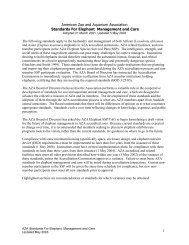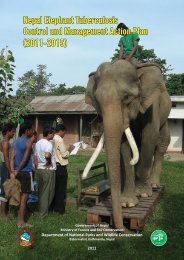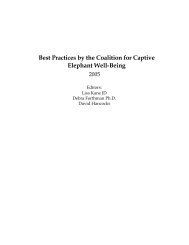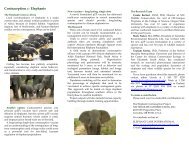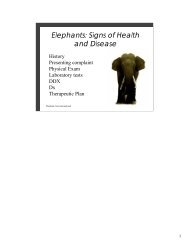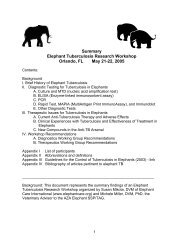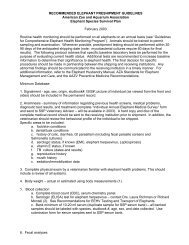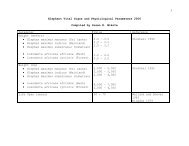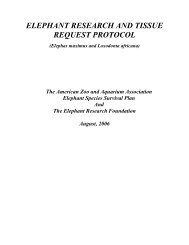BIRTH PROTOCOL - Elephant Care International
BIRTH PROTOCOL - Elephant Care International
BIRTH PROTOCOL - Elephant Care International
You also want an ePaper? Increase the reach of your titles
YUMPU automatically turns print PDFs into web optimized ePapers that Google loves.
Riddle’s <strong>Elephant</strong> and Wildlife Sanctuary<br />
<strong>Elephant</strong> Birth Protocol<br />
December 2001
Index<br />
Equipment and Supplies -- page 3<br />
Medical Supplies -- page 3<br />
Emergency Drugs and Dosages (Female) -- page 4<br />
Emergency Drugs and Dosages (Calf) -- page 4<br />
Monitoring Parturition -- page 5<br />
Typical Signs of Labor -- page 5<br />
Parturition -- page 6, 7<br />
Weight Measurements -- page 7<br />
Guidelines for Monitoring Parturition after Progesterone Drop (Dr. Dennis Schmitt) -- page 8<br />
2
Equipment and Supplies<br />
It is recommended that the following equipment and supplies be available for the birth:<br />
Equipment:<br />
• A 5-ton Hoist<br />
• Assortment of Slings or Belly Bands<br />
• Hand Winch and Come-Along<br />
• Bolt Cutters<br />
• Power Source<br />
• Portable Lights<br />
• Extension Cords<br />
• Rope<br />
• Wheat Bran or Sawdust<br />
• Trash Cans and Bags<br />
• Portable Scale<br />
• Tape Measure (seamstress)<br />
Medical Supplies:<br />
• Tincture of Iodine (7%) or Nolvasan Solution<br />
• Suture Material<br />
• Ob Gloves<br />
• Lubricant<br />
• Suction Unit<br />
• Oxygen Tanks<br />
• Towels and Packing Blankets<br />
• Stethoscope<br />
• Thermometer<br />
• Heat Pad<br />
• Human Breast Pump<br />
• First Aid Kit for Humans<br />
3
Suggested Available Drugs<br />
Emergency Drugs and Dosages for the Calf:<br />
Dopram - Calculate dose for calf at 0,5 mg/kg. Have prepared and labeled in a syringe.<br />
Give under the tongue or IV to stimulate respirations. Can repeat the dose or double the<br />
dose one time is necessary.<br />
200 lb (90 kg) calf = 45 mg (2,25 ml)<br />
250 lb (113 kg) calf = 56 mg (2,8 ml)<br />
300 lb (136 kg) calf = 68 mg (3,4 ml)<br />
Epinephrine - Calculate dose for calf at 0,1 ml/kg of 1:1000 solution. Have prepared and<br />
labeled in a syringe.<br />
Give inter-cardiac, intra-tracheal, or IV if there is no heartbeat.<br />
200 lb (90 kg) calf = 9 ml<br />
250 lb (113 kg) calf = 11,3 ml<br />
300 lb (136 kg) calf = 13,6 ml<br />
Calculate dosages for the following:<br />
Atropine - to dry respiratory secretions<br />
Sodium Bicarbonate - for acid balance if anoxic<br />
Tetanus Antitoxin - 3cc given IM - sometime in first weeks after birth<br />
Tetanus Toxoid - 1cc given IM - if injury with contamination occurs<br />
Have chart prepared for various weights/dosage<br />
Emergency Drugs and Dosages for the Female:<br />
Oxytocin – To induce labor, dose is 20-30 IU given IM or IV to start, increase if needed every<br />
20-30 minutes in 20-30 IU increments.<br />
- For milk letdown, dose is 40-60 IU IV. Only give one injection when needed for calf<br />
to nurse, or to obtain milk for bottle-feeding.<br />
Calculate dosages for the following:<br />
Lasix - to reduce edema if present after calving<br />
Lidocane - for local anesthesia if needed for episiotomy<br />
Calcium Gluconate - for calcium deficiency if present<br />
Tetanus Antitoxin - 3cc given IM at least 1 month prior to calving<br />
Antibiotics if indicated<br />
4
Monitoring Parturition<br />
Monitoring Progesterone<br />
<strong>Elephant</strong> gestation is approximately 659 days with a range of 612 to 699 days. African<br />
elephants may average slightly less, about 645 days.<br />
Serum progesterone levels will be monitored weekly throughout gestation. At 20 months<br />
(approx. day 620), twice weekly samples will be assayed. Daily assays will start at 20 ½<br />
months (day 640). As a general rule, before birth the progesterone levels will indicate a 50%<br />
decrease within twenty-four hours, and continue to decrease. Typically levels fall below<br />
100pg/ml from 1 to 10 days, with an average of 3 days, prior to parturition.<br />
Collecting Plasma<br />
At least 8 weeks prior to birth, weekly plasma collections from the mother will begin. One<br />
(450 ml.) bag a week will be collected and taken to a local laboratory for separation and<br />
storage. This plasma will be given orally to the calf if the mother will not allow the calf to<br />
nurse.<br />
The last plasma samples collected prior to birth will be the first plasma samples used because<br />
they will contain more antibodies than the first samples collected.<br />
Milk Analysis<br />
Calcium levels in elephant milk rise dramatically 12-48 hours prior to birth. However, it<br />
takes a substantial amount of fluid (2-3 ml) from the mammary gland to test. It is possible to<br />
use the commercial Foal Check system and also the water hardness kit available through a<br />
local water treatment business. If the water hardness test kit is used, the milk sample needs<br />
to be diluted 1 part milk to 9 parts distilled water for the kit to work. Direct use of milk<br />
results in calcium levels that are too high. Some females have not had any milk that could be<br />
obtained until about 24 hours before birth, and others have milk for weeks before birth.<br />
Typical Signs of Labor<br />
The following symptoms have been reported prior to the onset of labor in elephants:<br />
• Progesterone drop<br />
• Rise in calcium level in colostrum<br />
• Appetite loss<br />
• Passage of mucous plug<br />
• Occasional squatting, stretching and kicking<br />
• Frequent urination and/or defecation<br />
Night watches will begin at the start of the 21 st month and will consist of at least one<br />
experienced elephant handler and one volunteer. A remote video monitoring system with<br />
observations in and outside the elephant facility to facilitate a 24-hour watch will be used.<br />
5
Parturition<br />
When the first signs of labor appear, the elephant handlers will tether the elephant on 3 or 4<br />
leg restraints (chain or rope). It is recommended that inexperienced or nervous elephants be<br />
tethered so the newborn can be pulled if the mother becomes excited. Inexperienced<br />
elephants have rejected and even killed newborns. The newborn calf will be immediately<br />
removed from the mother. The female is allowed to calm down as she watches her infant<br />
being attended to. This period of separation gives the female time to recover from the shock<br />
of birth, gives the staff time to clean and inspect the baby, the veterinarian time to perform<br />
the neonatal exam, and the baby time to become steady on its feet. Wheat bran or sawdust<br />
will be spread around the floor to absorb the birth fluids. It is important that the floor be<br />
kept clean to prevent poor footing for humans and animals.<br />
The rest of the herd will be in adjacent stalls to avoid interfering with the elephant care staff<br />
but still observe the birth and newborn calf. It is important for all the females to witness the<br />
birth and after-care, as this is an invaluable learning experience. They may also need to be<br />
tethered if they become agitated.<br />
The role of each person involved in the birthing process will be defined in detail well in<br />
advance of the event. Only people with whom the elephants are familiar will be present<br />
during the birthing process. There will be one person, the elephant manager, in charge of all<br />
aspects of the event so it is carried out without needless discussion.<br />
The entire birth process will be recorded on videotape and a person will be designated to<br />
record all pertinent data (weight, measurements, etc.).<br />
Immediately after birth, the calf is pulled a short distance from the mother so she can smell<br />
and touch the calf but not grab or step on it. Extreme caution must be utilized at all times.<br />
Handlers must remain calm and alert for aggressive behavior from the mother particularly<br />
when the calf vocalizes or falls down. The floor is cleaned and bran or shavings are spread.<br />
The mother may not respond to commands as well as she usually does. Each situation is<br />
different so it must be evaluated as the process is going on.<br />
When the new mother has calmed down and it is determined to be safe, veterinary staff can<br />
enter the holding area to do the initial calf examination and treat the umbilicus. Veterinary<br />
staff should have on hand:<br />
a) Emergency Drugs and Supplies<br />
b) Oxygen given orally or up the trunk if the calf is hypoxic or respiratory problems are<br />
evident<br />
c) Tincture of Iodine or Nolvasan Solution (umbilicus area)<br />
d) Shop-Vac, Towels and Blankets to remove mucous from the trunk and mouth, and to dry<br />
and stimulate the calf<br />
e) Serum banked in advance and Milk Replacer in the event of maternal rejection<br />
6
The calf is allowed to attempt standing on its own (range from 5 minutes to 5 hours) after<br />
birth. The calf can be allowed with its mother when the elephant manager in charge is<br />
confident the mother is calm, interested and responsive.<br />
It is suggested that handlers use a strap to support the calf in standing. This has been found<br />
to be the time when the mother stresses (gets aggressive). When the calf is struggling to rise,<br />
or rises and then falls down emitting a squeal, this will excite the dam. The use of a strap<br />
between the front legs to support the calf until it is steady on its feet and able to walk about<br />
normally greatly reduces the mother’s concern. The strap (a soft rope with loops at both ends<br />
or a canvas strap works well) should go between the front legs on either side of the calf and<br />
be held by a keeper on each side. The calf doesn’t have a reverse when it begins walking so<br />
the reason to go between the front legs is to be able to pull the calf backwards rapidly from<br />
the mother if needed. Also small straps to put around the calf’s ankles quickly at the time of<br />
birth helps in pulling the calf away from the mother (the legs are large and very slippery) and<br />
prevents using the convenient handles (trunk and tail) to pull the calf away.<br />
The calf should be allowed to find the teat on its own. Range for initial suckling attempts is<br />
½ to 24 hours. Successful first nursing has varied from 1-10 days. Ideally successful nursing<br />
should occur within the first 12 hours to insure that the calf receives the necessary colostrum.<br />
If the calf does not nurse during the first 12 hours, the calf should be supplemented with<br />
either the mother’s colostrum or the banked serum.<br />
Weight and Measurements of the Calf<br />
The following weight and measurements are taken as the situation allows:<br />
• Body weight<br />
• Height to the top of the back<br />
• Length with trunk and tail relaxed<br />
• Heart girth<br />
• Body temperature<br />
• Heart rate<br />
• Respiratory rate<br />
The afterbirth is collected and examined to determine if the mother passed the entire<br />
placenta. The placenta is weighed and made available for research.<br />
The mother and calf are monitored closely after birth for a minimum of 24-48 hours. Milk<br />
consumption is very hard to assess; daily weights of the calf can determine if the calf is<br />
meeting its nutritional requirements. As with most animals, elephants may lose up to 10% of<br />
their birth weight the first few days after birth (in elephants this may last up to a week).<br />
Then calves should gain 2 to 2 ½ lbs. (about 1 kg.) a day. Stools need to be charted and<br />
monitored closely. Weather extremes are also a concern as calves are more sensitive to cold<br />
and heat then adults.<br />
7
Night watches will continue until the staff is comfortable that the calf is strong enough and<br />
the mother is not showing any aggression – this may be as long as several weeks after the<br />
birth. When introducing calves to adults, caution is utilized, as any aggressive move by an<br />
adult towards a newborn can be fatal. No matter what management system is used, it is<br />
important that the calf learn basic barn manners. If in free contact, the baby must learn to be<br />
careful around people. Playing with the baby is not permitted as it can lead to bad habits<br />
and confusion when it is time for formal training. Limited formal training begins within<br />
weeks depending on the individual animal’s temperament. If the juvenile is accustomed to<br />
some handling, this will enable the elephant care staff to easily perform simple procedures<br />
such as blood collections, treatment of injuries, eye and mouth examinations, etc., instead of<br />
attempting to tranquilize the animal. With the threat the herpes virus presents to young<br />
calves, husbandry training at a young age may save its life.<br />
8
Guidelines for Monitoring Parturition in an <strong>Elephant</strong> after Progesterone Drop<br />
1. After progesterone falls, the monitoring of stage I of parturition during normal cervical<br />
dilation and entrance of the placental membranes into the cervical canal and vagina can<br />
be accomplished by twice daily ultrasonography.<br />
a. It is possible to determine the imminent entrance of the extremities into the birth canal.<br />
b. The entrance of the feet into the birth canal usually is associated with overt signs of<br />
labor.<br />
c. With the entrance of feet into the birth canal far enough to be palpated the monitoring<br />
of parturition by ultrasonography is limited.<br />
2. When the feet can be palpated, monitoring of the movement of the fetus during stage II of<br />
parturition is possible.<br />
a. Progression of the fetus in the birth canal is measurable by palpation just prior to labor<br />
and after labor has begun. If the fetus has not progressed into the birth canal between<br />
three palpations 2–3 hours apart, then the use of oxytocin should be considered for<br />
induction of parturition.<br />
b. Oxytocin for labor induction in elephants should be used judiciously. Initial rates of<br />
administration should be 20-30 IU given IM. If additional administration is necessary<br />
then 20-30 minutes between injections should be observed with increases in dosages at<br />
20-30 IU considered.<br />
c. If oxytocin is not productive, alternative strategies should be discussed.<br />
3. After birth the calf should be examined and the umbilicus disinfected. Due to the unusual<br />
pattern that the umbilicus breaks, the disinfectant should be infused into the opening of<br />
the umbilical sheath. Use of tincture of iodine or nolvasan solution is recommended.<br />
During the first few days, disinfection of the calf’s umbilicus should occur several times a<br />
day.<br />
4. Following the birth of the calf, rectal palpation of the birth canal to eliminate the<br />
possibility of a second calf should be performed. This may be done prior to, or following,<br />
the delivery of the placenta.<br />
5. Examination of the placenta to ensure its complete delivery and its weight should be<br />
recorded.<br />
Prepared by Dr. Dennis Schmitt DVM, PhD, DACT<br />
3/20/00<br />
9




